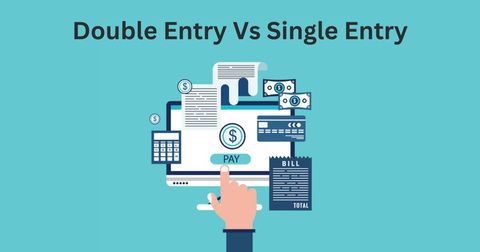

Single-entry bookkeeping and double-entry bookkeeping are two distinct methods of recording and managing financial transactions in accounting. Here are the key differences between these two systems:
Nature of Entry:
Single-Entry Bookkeeping: In a single-entry system, each financial transaction is recorded only once, typically in a simple ledger or journal. It records the basic details of a transaction, such as the date, description, and amount. This system usually tracks cash and bank transactions, but it may not comprehensively record all financial activities.
Double-Entry Bookkeeping: In a double-entry system, every financial transaction is recorded twice, with a debit entry and a corresponding credit entry. It follows the fundamental accounting equation: Assets = Liabilities + Equity. Each transaction affects at least two accounts, ensuring the equation remains in balance.
Completeness and Accuracy:
Single-Entry Bookkeeping: Single-entry bookkeeping may not capture all financial transactions, making it difficult to maintain an accurate and complete financial picture. It is prone to errors and omissions since it does not have a built-in mechanism to detect discrepancies or ensure that assets equal liabilities plus equity.
Double-Entry Bookkeeping: Double-entry bookkeeping is designed to record all financial transactions, providing a comprehensive and accurate representation of an organization's financial position. It is considered a more precise and reliable method for tracking and reporting financial data, as it follows standardized accounting principles and rules.
Financial Statements:
Single-Entry Bookkeeping: These systems are not well-suited for preparing detailed financial statements, such as balance sheets, income statements, and cash flow statements. As a result, stakeholders may not have access to essential financial information required for decision-making.
Double-Entry Bookkeeping: It allows for the preparation of comprehensive financial statements, providing a clear view of an organization's financial health. Stakeholders, including investors, creditors, and management, can use these statements to assess an organization's performance, liquidity, and solvency.
Consistency and Control:
Single-Entry Bookkeeping: It lacks formal rules and guidelines, which can result in inconsistent recording practices. This system may be more susceptible to errors, fraud, and inefficiencies.
Double-Entry Bookkeeping: It follows standardized accounting principles and practices, promoting consistency and making it easier for auditors and accountants to review and verify financial records. It provides better financial control by requiring transactions to balance and affect at least two accounts.
In summary, the key difference between single-entry and double-entry bookkeeping lies in the method of recording and the completeness and accuracy of the financial information.
Single-entry bookkeeping is a simpler and less comprehensive system, primarily used by small businesses, while double-entry bookkeeping is the standard and more robust method used by most organizations to maintain accurate and transparent financial records.
Comments
Write Comment